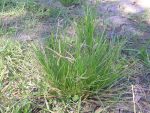 Also called wiregrass, this small annual grass is a member of the grass family, Poaceae, that also includes oats, bamboo, and rice. It is native to warm climates around the world where it thrives in poorly drained compacted soils and is found in disturbed areas including roadsides, lawns, golf courses, sports fields, and cultivated crops. Goose grass germinates in late spring usually after crabgrass, and grows all summer. It looks very much like crabgrass but unlike crabgrass only grows in clumps rather than spreads over the ground.
Also called wiregrass, this small annual grass is a member of the grass family, Poaceae, that also includes oats, bamboo, and rice. It is native to warm climates around the world where it thrives in poorly drained compacted soils and is found in disturbed areas including roadsides, lawns, golf courses, sports fields, and cultivated crops. Goose grass germinates in late spring usually after crabgrass, and grows all summer. It looks very much like crabgrass but unlike crabgrass only grows in clumps rather than spreads over the ground.
Description: Growing from a central tap root with a fibrous root system, goosegrass clumps have smooth, flattened or folded leaves that are three to twenty-four inches long, bear hairs along their edges, and are white or silver at the base. In late summer seedheads emerge with two to ten finger-like spikes with a common center at the tip of the stem. The spiklets on each spike grow in a herringbone pattern resembling a zipper. Plants can produce seeds even when closely mowed and a single plant can produce up to 50,000 seeds.
Control: Improving the soil conditions such as fertility, compactness, and drainage to encourage desirable plant species is an important step in goosegrass control. Following measures include hand pulling small plants and digging out older ones with a turning fork or spade before seed set. If the problem persists the soil can be covered with a dense mulching material such as plastic or cardboard. Mowing is not effective because plants can withstand mowing heights as low as 0.125 inches. In severe cases pre emergent and post emergent herbicides can be effective but some strains of the weed are resistant to some herbicides including glyphosate.
Photo Credit: Harry Rose, Wikimedia Commons